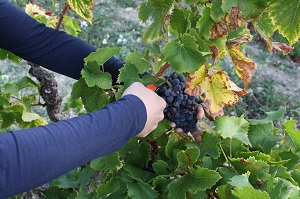The harvest banns or "ban des vendanges"
Traditionally, this was the document that gave permission to start the harvest, and also to get the harvest celebrations under way. Today, some regions in France still fix the earliest possible date to start the harvest. From the set date, the winemakers can begin to harvest the grapes, but they are also free to start harvesting later if they feel that their grapes would benefit from maturing more before being picked. In other regions, the winemakers themselves have complete autonomy over when to harvest their grapes.
Harvest period
So it's no longer just the official decree that marks the start of the harvest, but it's also the choice of the winemaker. For each grape varietal and vineyard plot, the right equilibrium has to be found between the grapes being sufficiently mature and waiting too long if there are any climatic risks such as rain, storms, or drought. The winemaker has to be able to deal with the stress of uncertainty!

The state of the grapes
The winemakers decisions are therefore based on the state of the grapes in each individual vine plot. As the grapes mature, the sugar level rises and the acidity decreases. If the winemaker waits too long, the sugar level will be too high and the grapes will be overripe. The water in the berries will start to evaporate and the grapes will start to dry out. For some types of wine, such as vendanges tardives, this is the stage that the winemaker will wait for before picking the grapes.
Late harvest or "vendanges tardives"
Outside of the usual harvest period, some grape varietals and wine appellations have been granted specific authorisation to enable a late harvest. In these cases, we're looking for a high concentration of sugar and so choose to harvest later. The mention of "vendanges tardives" on a label is regulated, and in France it is allowed in Alsace, and in the Gaillac and Jurançon appellations, each having their own specific charters.
Green harvest
So you can harvest later, but you can also pick your grapes earlier with a green harvest. But note that a green harvest is never intended to pick grapes for making wine. It's simply to remove excess grapes from the vines during the ripening or véraison" period. By decreasing the yield, the winemaker can increase the quality of the remaining grapes.
Harvesting machine
Once the grapes have ripened, it's time to pick them. To do so the winemaker can use a harvesting machine or lots of pairs of secateurs! The harvesting machine has the advantage of being quick and of being able to be used more flexibly in terms of time. The proponents of manual harvesting argue that the quality of the harvest is better by hand, as a first sort can be done of the grapes before they are transported to the chai.
Sorting table
Talking of sorting the grapes, this can be done at two stages, at the moment the grapes are picked, or on a sorting table at the chai, where the unwanted grapes and foliage are removed, and often the stems are removed at the same time for red wine grapes. The winemaker chooses one or the other method, or sometimes both for the very best quality harvest. For some appellations, you have to sort when picking the grapes, or to harvest in phases by making multiple passes, as is the case for some of the sweet wines.
Destemming
Once the grapes have been sorted, the winemaker might decide to separate the berries from the stems, particularly for red wines, before the grapes are pressed or left to macerate in the fermentation tanks. Removing the stalk avoids too much contact with the grape must that can give a bitter vegetal taste. If the stalk is mature enough, the winemaker might decide to leave some of the stalk to add some tannin to the wine, and make a wine that will keep longer.
Wine press
To make white wine or some rosé wines, the grapes are pressed. Pressing can be done in a number of different types of wine press; vertically, horizontally, pneumatic or hydraulic. Each has their own advantages, but the pneumatic presses are most often used nowadays because you can regulate the pressure applied to the grapes to obtain a better quality juice. For the red wines, there is no pressing done before the fermentation, but afterwards to separate the solid marc of stems, skin and pips from the wine.
Crushing the grapes
For many wines, the grapes aren't crushed before being pressed or macerated. They are either left to break down naturally, or can be crushed mechanically or by foot. The days of crushing grapes by foot are very rare now as it takes a lot of time and energy! So these are some of the principal steps that will keep the winemaker busy up to and during the harvest. But it doesn't stop there! Once the grapes and juice are safely in the vats, the vinification process starts. We then hear talk of fermentation, racking, chaptilisation, yeast, sulphites... but we'll talk more about that after the harvest!
Other articles relating to the harvest
- A brief history of grape harvesting
Comments
No comments.




